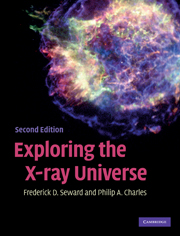Book contents
- Frontmatter
- Contents
- List of acronyms
- Foreword
- Chapter 1 Birth and childhood of X-ray astronomy
- Chapter 2 X-ray emission and interaction with matter
- Chapter 3 Tools and techniques
- Chapter 4 Solar system X-rays
- Chapter 5 X-ray absorption and scattering in the Interstellar Medium
- Chapter 6 Active stellar coronae
- Chapter 7 Early-type stars
- Chapter 8 Supernova explosions and their remnants
- Chapter 9 Neutron stars, pulsars, pulsar wind nebulae, and more supernova remnants
- Chapter 10 Cataclysmic variable stars
- Chapter 11 X-ray binaries
- Chapter 12 Black-hole X-ray binaries
- Chapter 13 Normal and starburst galaxies
- Chapter 14 Active galactic nuclei
- Chapter 15 Clusters of galaxies
- Chapter 16 The diffuse X-ray background
- Chapter 17 Gamma-ray bursts
- Index
- Plate section
Chapter 11 - X-ray binaries
Published online by Cambridge University Press: 05 June 2012
- Frontmatter
- Contents
- List of acronyms
- Foreword
- Chapter 1 Birth and childhood of X-ray astronomy
- Chapter 2 X-ray emission and interaction with matter
- Chapter 3 Tools and techniques
- Chapter 4 Solar system X-rays
- Chapter 5 X-ray absorption and scattering in the Interstellar Medium
- Chapter 6 Active stellar coronae
- Chapter 7 Early-type stars
- Chapter 8 Supernova explosions and their remnants
- Chapter 9 Neutron stars, pulsars, pulsar wind nebulae, and more supernova remnants
- Chapter 10 Cataclysmic variable stars
- Chapter 11 X-ray binaries
- Chapter 12 Black-hole X-ray binaries
- Chapter 13 Normal and starburst galaxies
- Chapter 14 Active galactic nuclei
- Chapter 15 Clusters of galaxies
- Chapter 16 The diffuse X-ray background
- Chapter 17 Gamma-ray bursts
- Index
- Plate section
Summary
Introduction
The discovery of binary behaviour
The very existence of the bright cosmic X-ray sources discovered in the 1960s represented an exciting and challenging astrophysical problem. No physical process known then was capable of generating the enormous X-ray luminosities observed. The subsequent optical identifications of Sco X-1 and Cyg X-2 stimulated theorists and observers alike to learn more about these new ‘X-ray stars’. Why were these extremely powerful X-ray sources associated with such apparently unremarkable optical objects (see Chapter 1)? They were rather faint (13th to 15th magnitude) and did not stand out on optical photographs. However, the optical spectrum of Sco X-1 had similarities with the cataclysmic variables that were being intensively monitored by amateur groups and had been shown, a few years earlier, to be interacting binary systems (see Chapter 10).
As shown in Fig. 11.1, Sco X-1 displayed a smooth blue continuum with superposed emission lines of hydrogen and ionised helium. The absence of absorption features, as in normal stellar spectra, indicated that little or none of the light was coming from a main sequence star. The presence of ionised helium indicated that the source of excitation of the lines was very hot and very likely to be connected with the X-rays. However, despite many observing campaigns dedicated to Sco X-1, which revealed substantial variability on all timescales, no indication of binary behaviour was found. The same was true for Cyg X-2.
- Type
- Chapter
- Information
- Exploring the X-ray Universe , pp. 171 - 241Publisher: Cambridge University PressPrint publication year: 2010
- 1
- Cited by



